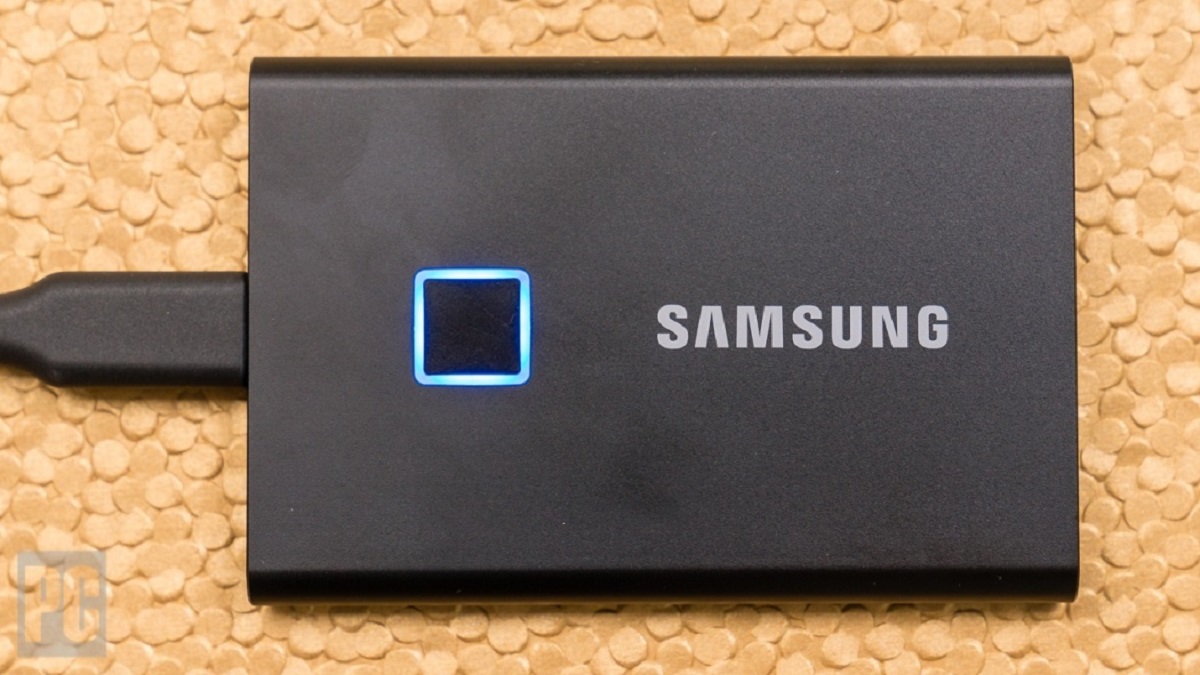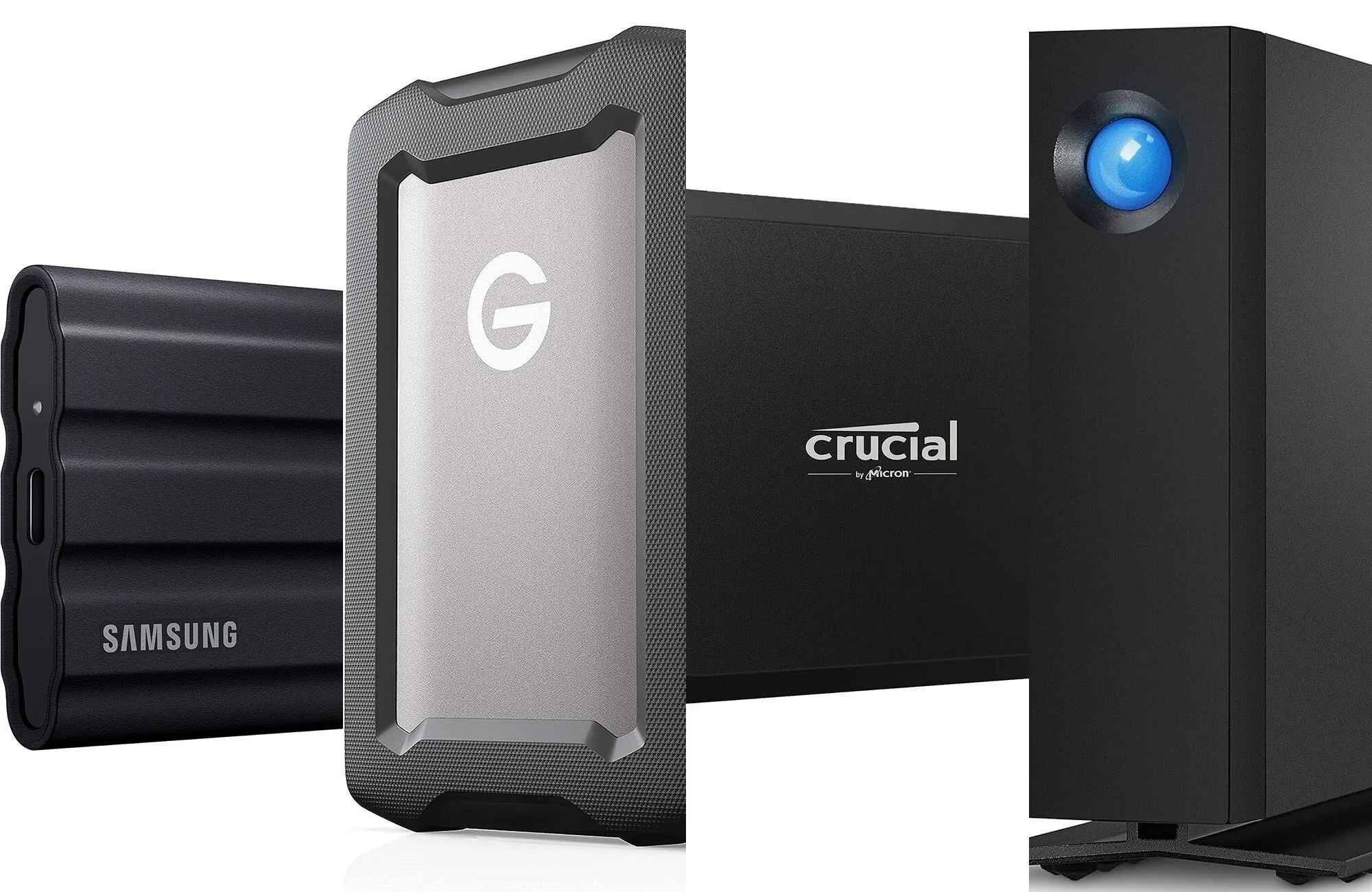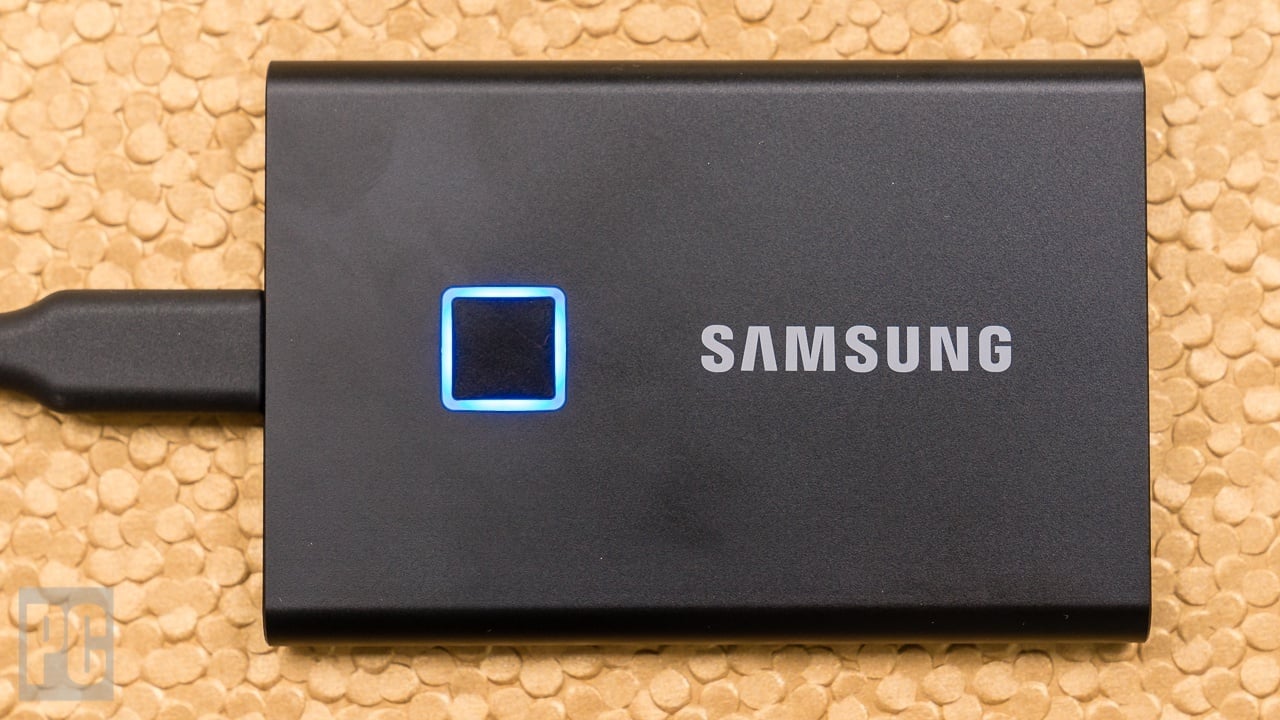Introduction
What is an External SSD Used For?
An external Solid-State Drive (SSD) is a portable storage device that provides a convenient and efficient way to store and access data. It offers significant advantages over traditional hard disk drives (HDDs) in terms of speed, durability, and compactness. In recent years, the popularity of external SSDs has grown rapidly, thanks to their versatility and wide range of applications.
Unlike internal SSDs that are installed inside a computer or laptop, external SSDs connect to devices via USB or Thunderbolt ports, making them easily portable and compatible with various devices, including laptops, PCs, gaming consoles, and even smartphones. They come in different storage capacities and price ranges, allowing users to choose the one that best suits their needs.
The primary purpose of an external SSD is to provide additional storage space and backups, but their functionality extends far beyond that. They have become an essential tool for professionals and casual users alike, offering a range of benefits and diverse applications.
This article aims to explore the uses and advantages of external SSDs, shedding light on how they can enhance productivity and convenience in various scenarios. From data backup to fast file transfers, gaming, video editing, and music production, the possibilities are endless when it comes to leveraging the power of external SSDs.
Let’s delve deeper into the vast array of uses for external SSDs, discovering how they can revolutionize your computing experience and offer unparalleled performance and versatility for your storage needs.
Definition of an External SSD
Understanding the External SSD
An external Solid-State Drive (SSD) is a portable storage device that uses flash memory technology to store and retrieve data. It serves as an external extension to a computer’s internal storage, providing additional space that can be accessed easily and conveniently.
Unlike traditional hard disk drives (HDDs), which use spinning magnetic disks to store data, external SSDs utilize solid-state memory chips to store information. This flash memory technology offers several advantages, including faster data transfer speeds, increased reliability, and improved durability.
External SSDs are designed to be lightweight and compact, making them highly portable and suitable for on-the-go use. They typically connect to devices via USB or Thunderbolt ports, ensuring compatibility with a wide range of devices, including laptops, desktop computers, gaming consoles, and digital cameras.
These drives come in various storage capacities, ranging from a few gigabytes to several terabytes, allowing users to choose the size that best suits their needs. With the advent of advancements in technology and decreasing prices, external SSDs have become more affordable, making them accessible to a wider audience.
External SSDs offer several benefits over traditional HDDs. Firstly, they provide significantly faster read and write speeds, allowing for quick file transfers and improved responsiveness when accessing data. This makes them ideal for tasks that demand high-speed data processing, such as video editing, gaming, and multimedia production.
Furthermore, external SSDs are more resistant to physical shocks and vibrations, thanks to their lack of moving parts. This makes them more durable and reliable, reducing the risk of data loss or corruption due to accidental drops or impacts.
Overall, the combination of speed, reliability, and portability makes external SSDs an excellent choice for users seeking enhanced performance and flexibility in their storage solutions.
In the following sections, we will explore the various uses and advantages of external SSDs, highlighting their versatility and potential to streamline workflows in different professional and personal scenarios.
Benefits of Using an External SSD
Unlocking the Advantages of External SSDs
Using an external Solid-State Drive (SSD) brings a multitude of benefits that can greatly enhance your computing experience. These advantages make external SSDs an appealing choice for both personal and professional use. Let’s explore some of the key benefits of utilizing an external SSD:
- Speed and Performance: One of the most significant advantages of external SSDs is their lightning-fast data transfer speeds. Compared to traditional hard disk drives (HDDs), which are limited by mechanical parts, SSDs excel in delivering quick and responsive performance. With an external SSD, you can save and retrieve files in a fraction of the time, allowing for more efficient workflows and reduced waiting times.
- Portability and Convenience: External SSDs are designed to be compact and lightweight, making them highly portable. Whether you need to transfer files between different computers or carry your data with you on the go, an external SSD provides the perfect solution. Its small form factor allows for easy storage in a backpack, purse, or pocket, making it a convenient tool for students, professionals, and travelers.
- Durability and Reliability: Unlike traditional HDDs, which consist of moving mechanical parts, external SSDs have no moving components. This solid-state construction makes them more resistant to physical shocks, vibrations, and extreme temperatures. With an external SSD, you can rest assured that your data is safe, even in challenging environments.
- Energy Efficiency: External SSDs consume less power than HDDs. Since SSDs have no mechanical parts to spin or move, they require less energy to operate. This energy efficiency not only prolongs the battery life of your portable devices but also contributes to a greener and more sustainable computing experience.
- Data Security: External SSDs offer enhanced data security. Many SSDs come with advanced encryption capabilities, allowing you to protect your sensitive files and confidential data. Whether you’re a business professional safeguarding client information or an individual protecting personal files, an external SSD can provide the peace of mind of knowing that your data is secure.
- Ease of Use: External SSDs are designed to be plug-and-play, requiring no additional software or drivers to function. With a simple connection, you can instantly access and transfer files without any complicated setup processes. This ease of use makes external SSDs suitable for users of all skill levels.
By leveraging the benefits of an external SSD, you can enjoy faster performance, increased convenience, and enhanced data security. In the following sections, we will explore the many practical uses for external SSDs, highlighting how they can optimize productivity and streamline workflows in various scenarios.
Common Uses for External SSDs
Unlocking the Potential of External SSDs
External Solid-State Drives (SSDs) offer a wide range of uses and applications that can revolutionize your computing experience. Whether you’re a student, professional, content creator, or casual user, there are numerous ways to harness the power of an external SSD. Let’s explore some of the common uses for external SSDs:
- Portable Storage: The primary use of an external SSD is to provide additional storage space for your files and data. Whether you need to store large multimedia files, documents, or software applications, an external SSD offers a compact and portable solution. This is especially useful for laptops and tablets with limited internal storage.
- Backup and Recovery: External SSDs are ideal for backing up important data and creating system backups. They offer a reliable and efficient way to ensure that your files are protected in case of a hard drive failure or system crash. With fast transfer speeds, you can quickly backup or restore your data, providing peace of mind and minimizing downtime.
- Fast File Transfers: External SSDs excel in providing quick and seamless file transfers. Whether you’re transferring large media files, software installations, or large datasets, an external SSD can significantly reduce the time it takes to complete such tasks. This makes them invaluable for professionals working with large files or individuals who frequently need to transfer data between devices.
- Gaming and Multimedia: External SSDs are a game-changer for gamers and multimedia enthusiasts. They can be used to store and access video games, allowing for faster load times and smoother gameplay. Additionally, external SSDs are perfect for storing high-resolution videos, photos, and music libraries, providing instant access to your multimedia files without any lag.
- Software Development and Virtual Machines: For software developers and individuals working with virtual machines, external SSDs offer increased efficiency. They provide a robust platform for running resource-intensive development environments, allowing for faster compiling, testing, and execution of code. External SSDs make it easier to create and manage virtual machines, enhancing productivity and reducing development time.
- Video Editing and Photography: Video editors and photographers often work with large files that require fast and reliable storage solutions. External SSDs offer the speed and capacity needed for efficient media management. With an external SSD, you can seamlessly edit and store high-resolution videos and images, eliminating bottlenecks and ensuring smooth workflow.
- Digital Music Production: Musicians and producers can benefit greatly from the high-speed capabilities of external SSDs. Recording, editing, and playing back audio files can be done seamlessly with an external SSD, providing a stable and responsive storage environment for digital music production. Whether you’re composing music or DJing, an external SSD ensures that your audio projects are handled with precision and efficiency.
These are just a few examples of how external SSDs can be utilized in various domains. Their speed, reliability, and portable nature make them a versatile tool for enhancing productivity and making the most out of your digital workflow.
Now that we have explored the common uses and benefits of external SSDs, let’s dive deeper into each of these applications to understand how they can transform your computing experience.
1. Portable Storage
Harnessing the Portability of External SSDs
One of the primary uses for external Solid-State Drives (SSDs) is portable storage. With the increasing amounts of digital files we accumulate, having a reliable and portable storage solution is essential. External SSDs provide the ideal solution for individuals on the go who need to carry their files with them.
External SSDs are designed to be compact and lightweight, making them highly portable and convenient to carry around. They easily fit into a backpack, briefcase, or even a pocket, allowing you to bring your files wherever you go. Whether you’re a student, professional, or traveler, portable storage is a necessity in today’s fast-paced digital world.
With an external SSD, you can transfer and store large quantities of data, including documents, photos, videos, music, and more. This eliminates the need to rely solely on the limited internal storage of your device. Whether you’re working on a laptop, tablet, or smartphone, an external SSD offers the flexibility to expand your storage capacity effortlessly.
Portable storage with an external SSD offers several benefits:
- Convenience: With an external SSD, you can carry your files with you wherever you go. Whether you’re traveling, working remotely, or attending meetings, having your essential files readily available is invaluable. No more worrying about running out of space or being dependent on an internet connection to access your files.
- Data Organization: External SSDs enable you to keep your files organized and easily accessible. You can categorize your files into folders and directories, making it effortless to retrieve specific documents or media files when needed. This level of organization can save valuable time, especially when working on multiple projects or assignments simultaneously.
- Collaboration: External SSDs facilitate collaboration, as they can be easily passed between colleagues or shared with clients. Whether you’re working on a group project, sharing presentation files, or collaborating on creative work, an external SSD offers a simple and efficient method for exchanging files and collaborating seamlessly.
- Backup and Recovery: Portable storage isn’t just about carrying files; it also serves as an essential backup solution. With an external SSD, you can create backups of your important files, protecting them from accidental deletion, hardware failures, or malware attacks. This ensures that your data is safe and recoverable in case of any unforeseen events.
- Cross-Platform Compatibility: External SSDs are designed to be compatible with various devices, including laptops, desktops, tablets, and smartphones. They can be easily connected via USB or Thunderbolt ports, allowing for seamless file transfers between different platforms and operating systems. This versatility makes external SSDs an efficient storage solution for individuals who use multiple devices.
Overall, portable storage with an external SSD offers convenience, flexibility, and peace of mind. With the ability to carry your files with you and easily transfer them between devices, you can enhance your productivity and workflow, whether you’re a student, professional, or digital nomad.
Now that we have explored portable storage with external SSDs, let’s delve into another common use: backup and recovery.
2. Backup and Recovery
Safeguarding Your Data with External SSDs
One of the most critical uses for external Solid-State Drives (SSDs) is backup and recovery. Protecting your valuable data from loss or corruption is essential, and external SSDs offer a reliable and efficient solution for safeguarding your files.
External SSDs provide the ideal platform for creating backups of important files and systems. They offer fast data transfer speeds, ensuring that the backup process is quick and efficient. With the increasing size of files and the prevalence of multimedia content, having a high-speed backup solution is crucial to avoid lengthy and time-consuming backup procedures.
Backing up your data to an external SSD offers several advantages:
- Data Protection: By creating backups on an external SSD, you ensure that your files are safe from data loss or corruption. In the event of a hardware failure, system crash, or accidental deletion, you can easily recover your files from the external SSD, minimizing the risk of permanent data loss.
- Quick Recovery: External SSDs provide fast access to your backup files, allowing for quick recovery in case of a data loss situation. Whether you need to recover a single file or restore an entire system, the high read speeds of external SSDs ensure a prompt and efficient recovery process, minimizing downtime and productivity loss.
- System Restoration: External SSDs enable you to create system backups, including operating systems, applications, and settings. This allows for easy restoration of your entire system in case of a catastrophic software failure or malware attack. By having a complete system backup on an external SSD, you can quickly get back up and running with minimal disruption.
- Versioning and History: External SSDs offer the capability to create multiple backups, allowing you to keep different versions of your files or create a history of your data. This is particularly useful when working on projects that undergo frequent updates or revisions. With multiple backups on an external SSD, you can easily revert to a previous version of a file if needed.
- Long-Term Storage: External SSDs are designed to be durable and reliable, making them an excellent long-term storage solution for your backups. Unlike traditional hard disk drives (HDDs), which are susceptible to mechanical failures, external SSDs have no moving parts, reducing the risk of data loss due to physical damage. This ensures that your backups remain intact and accessible for an extended period.
By utilizing external SSDs for backup and recovery, you can have peace of mind knowing that your critical files and systems are protected. Whether you’re a business professional, student, or home user, having a reliable backup strategy using an external SSD is essential for preserving your important data.
In the next section, we will explore another common use for external SSDs: fast file transfers.
3. Fast File Transfers
Efficiency and Speed with Fast File Transfers on External SSDs
One of the standout features of external Solid-State Drives (SSDs) is their ability to provide lightning-fast file transfers. With their superior read and write speeds, external SSDs offer an efficient and time-saving solution for transferring files between devices.
Whether you’re working with large multimedia files, transferring software installations, or moving datasets, external SSDs excel in delivering quick and seamless file transfers. Compared to traditional hard disk drives (HDDs), which are limited by mechanical parts, external SSDs can significantly reduce transfer times, improving overall productivity.
Fast file transfers on external SSDs offer several benefits:
- Time Savings: With their high-speed transfer capabilities, external SSDs can help you save valuable time when moving files. Whether you’re backing up your data, sharing files with colleagues, or simply moving large media files, the fast speeds of external SSDs ensure that your transfers are completed in a fraction of the time compared to HDDs.
- Improved Productivity: Faster file transfers mean less time waiting and more time working on essential tasks. For professionals who frequently transfer large files, such as designers, videographers, and engineers, using an external SSD can significantly streamline workflows and improve productivity. Time saved during file transfers translates to increased efficiency and the ability to focus on more critical aspects of your work.
- Seamless Workflow: External SSDs allow for quick and efficient file transfers, promoting a seamless workflow between devices. Whether you’re moving files between a desktop computer and a laptop, transferring data to a client’s device, or syncing media files across multiple devices, the fast transfer speeds of external SSDs ensure that your workflow remains uninterrupted and efficient.
- Large File Support: With the growing size of files, especially in multimedia and design industries, external SSDs offer the capacity and speed needed to handle large file transfers effectively. Whether you’re working with high-resolution videos, intricate 3D models, or large datasets, an external SSD can handle the demands of these files without compromising performance or speed.
- Flexibility and Portability: External SSDs are not only fast but also highly portable. Their compact size and lightweight design make them convenient for on-the-go professionals. Whether you need to transfer files during business trips, presentations, or meetings, external SSDs provide the flexibility to carry your data with you and transfer files quickly and efficiently.
By utilizing the fast file transfer capabilities of external SSDs, you can save time, increase productivity, and enhance your workflow. Whether you’re a professional working with large files or an individual who frequently transfers data between devices, an external SSD offers a significant advantage in terms of speed and efficiency.
In the next section, we will explore another exciting use for external SSDs: gaming and multimedia.
4. Gaming and Multimedia
Unleashing Performance with External SSDs for Gaming and Multimedia
External Solid-State Drives (SSDs) have become a game-changer for gamers and multimedia enthusiasts alike. The speed, reliability, and storage capacity of external SSDs make them an excellent choice for enhancing the gaming experience and managing large multimedia files.
When it comes to gaming, external SSDs offer several advantages:
- Faster Load Times: By installing games on an external SSD, you can significantly reduce loading times. The high read speeds of external SSDs ensure that games load quickly, allowing you to jump into the action without delay. Whether you’re playing intense multiplayer battles or exploring open-world adventures, an external SSD provides a seamless gaming experience.
- Improved Game Performance: With an external SSD, games can run smoother and exhibit better overall performance. The faster data access and transfer speeds eliminate bottlenecks, ensuring that the game can load and process data more efficiently. This leads to reduced lag, faster in-game rendering, and improved responsiveness, ultimately enhancing your gaming experience.
- Expanded Game Library: External SSDs offer ample storage space to expand your game library. With the increasing size of modern games, the limited internal storage of gaming consoles or laptops can quickly fill up. By utilizing external SSDs, you can store and access a larger number of games without worrying about running out of space.
- Portability and Flexibility: External SSDs allow gamers to take their gaming library with them wherever they go. Whether you’re visiting a friend’s house, attending gaming tournaments, or traveling, an external SSD offers the convenience of easily connecting your games to different devices. This portability eliminates the need to reinstall games or rely on slow internet downloads.
- Future Proofing: External SSDs provide a versatile storage solution that can adapt to different gaming platforms. With the ability to connect to various devices, including gaming consoles, PCs, and laptops, an external SSD ensures that your games remain accessible and compatible with future hardware upgrades or platform changes.
Beyond gaming, external SSDs are invaluable for managing large multimedia files:
- Media Storage: For photographers, videographers, and graphic designers, external SSDs provide ample space to store and manage high-resolution images, videos, and other multimedia assets. By utilizing the speed and capacity of external SSDs, professionals can seamlessly access and edit their media files, ensuring smooth workflows and efficient production processes.
- Video Editing: Video editing requires rapid access to large video files and seamless playback during the editing process. External SSDs offer the speed and performance necessary for smooth video editing workflows. You can import, edit, and export high-resolution videos with ease, reducing rendering times and increasing efficiency in post-production tasks.
- Music Production: Musicians and music producers can benefit from the high transfer speeds and reliability of external SSDs. Whether you’re recording, mixing, or producing music, an external SSD provides a stable and responsive storage environment. This enables smoother audio processing, reduces latency, and ensures that your digital audio workstation (DAW) performs optimally.
By leveraging the power of external SSDs, gaming enthusiasts and multimedia professionals can take their experiences to a whole new level. With faster load times, improved performance, and ample storage space, external SSDs provide the performance and capacity needed for seamless gaming and multimedia production.
In the upcoming section, we will explore how external SSDs can enhance software development and virtual machine environments.
5. Software Development and Virtual Machines
Enhancing Efficiency in Software Development and Virtual Machine Environments
External Solid-State Drives (SSDs) offer significant benefits for software developers and individuals working with virtual machines (VMs). The speed, reliability, and capacity of external SSDs make them a valuable tool for enhancing efficiency in software development and managing VM environments.
External SSDs provide numerous advantages in software development:
- Accelerated Compiling and Building: Software development often involves compiling and building large codebases. With an external SSD, the read and write speeds are significantly faster compared to traditional hard disk drives (HDDs). This results in quicker compiling processes, reducing time wasted waiting for code to compile and allowing developers to iterate more efficiently.
- Improved Testing and Debugging: External SSDs enable developers to set up and run virtual machines for testing and debugging purposes. VMs require fast storage access to ensure smooth operation and prevent bottlenecks. With the high-speed capabilities of external SSDs, developers can create and manage VMs with ease, resulting in more efficient testing and debugging workflows.
- Easy Environment Setup: Development environments often require a specific setup, including programming languages, libraries, and tools. External SSDs allow developers to set up portable development environments that can be easily transferred between devices. This flexible storage solution enables developers to work on multiple machines without the need for extensive reconfiguration, maximizing productivity and reducing setup time.
- Resource-Intensive Applications: Certain software development tasks, such as running simulations, artificial intelligence (AI) models, or data analysis, require significant amounts of storage and processing power. External SSDs can handle these resource-intensive applications. By utilizing their fast transfer speeds and ample storage capacity, developers can efficiently process and analyze large datasets, creating more accurate and efficient solutions.
- Collaboration and Code Sharing: External SSDs provide a convenient way to share code and collaborate on projects. Whether you’re working on a team project or collaborating with remote colleagues, an external SSD allows for effortless code sharing and synchronization. This promotes a seamless collaboration process, ensuring that all team members have access to the latest codebase and working files.
In addition to software development, external SSDs play a crucial role in managing virtual machine (VM) environments:
- Efficient Resource Allocation: External SSDs offer the capacity to host and manage multiple virtual machines, allowing for efficient resource allocation. With an external SSD, you can allocate separate storage space and resources for each VM, ensuring optimum performance and preventing interference between different virtual environments.
- Rapid VM Provisioning: With an external SSD, provisioning new virtual machines becomes faster and more efficient. The high read and write speeds of external SSDs enable quick creation and deployment of VM instances, reducing provisioning time and facilitating dynamic scaling of virtual environments.
- Snapshot and Cloning: External SSDs support snapshot and cloning functionalities, which are essential for VM management. Snapshots allow you to capture the state of a VM at a particular point in time, enabling easy rollback in case of issues or changes. Cloning allows for the rapid replication of VMs, allowing you to create multiple instances from a single VM template with minimal effort.
By utilizing external SSDs in software development and virtual machine environments, developers can experience increased productivity, reduced waiting times, and smoother workflows. The speed, reliability, and storage capacity of external SSDs contribute to the efficiency and effectiveness of software development processes and VM management.
In the next section, we will explore how external SSDs can optimize video editing and photography workflows.
6. Video Editing and Photography
Optimizing Workflows in Video Editing and Photography with External SSDs
External Solid-State Drives (SSDs) have become an essential tool for professionals and enthusiasts in the fields of video editing and photography. The speed, reliability, and storage capacity offered by external SSDs greatly enhance workflows in these creative industries, allowing for efficient file management and seamless editing processes.
In the realm of video editing, external SSDs offer numerous advantages:
- Fast Media Access: External SSDs deliver lightning-fast read and write speeds, providing quick access to large video files. This speed allows for smooth playback during the editing process and reduces the time spent waiting for files to load. The seamless media access provided by external SSDs ensures that video editors can work efficiently and maintain their creative momentum.
- High Data Transfer Rates: Transferring large video files between devices can be time-consuming, especially with traditional hard disk drives (HDDs). External SSDs address this issue with their high data transfer rates. By utilizing external SSDs, video editors can quickly and effortlessly move files between different workstations or share their work with clients, significantly improving collaboration and productivity.
- Smooth Video Rendering: Rendering edited videos is a resource-intensive process that can take a significant amount of time. External SSDs allow for faster rendering times compared to HDDs, resulting in faster exports and quicker feedback cycles. This speed optimization enables video editors to deliver their projects on time and ensure a smooth post-production workflow.
- Flexible Storage Solutions: The large storage capacity of external SSDs is essential for video editors who work with high-resolution video files and multiple projects simultaneously. External SSDs offer ample space to store raw footage, edited projects, and media assets, ensuring that everything is readily accessible without the need to constantly juggle and delete files.
- Portability and Versatility: External SSDs are designed to be highly portable, making them ideal for video editors who need to work on different devices or collaborate with others on location. By simply connecting their external SSD, video editors gain access to their entire media library, allowing for seamless editing and consistent project management across multiple workstations.
In the realm of photography, external SSDs also play a crucial role:
- Ample Storage Capacity: Modern photographers capture images in high resolution, resulting in larger file sizes. External SSDs offer ample storage capacity to accommodate these large files. Photographers can store their RAW files, edited images, and complete portfolios on external SSDs, ensuring that their work is easily accessible and protected.
- Efficient File Management: External SSDs facilitate efficient file management for photographers. With their fast read and write speeds, photographers can quickly sort, organize, and transfer their images. This efficient file management workflow allows photographers to locate specific images effortlessly, reducing the time spent on file organization and increasing productivity.
- Easy Backup and Archive: External SSDs provide a reliable solution for backing up and archiving photography work. By regularly creating backups on external SSDs, photographers safeguard their images from loss or corruption. Additionally, external SSDs are durable and can serve as long-term storage solutions, ensuring that valuable images are protected for years to come.
With the speed, reliability, and storage capacity offered by external SSDs, video editors and photographers can optimize their workflows, improving productivity and streamlining their creative processes. Whether it’s seamless video editing or efficient file management for photography, external SSDs provide the performance and capabilities necessary to meet the demands of these visual media industries.
In the following section, we will explore how external SSDs enhance workflows in digital music production.
7. Digital Music Production
Revolutionizing Workflows in Digital Music Production with External SSDs
External Solid-State Drives (SSDs) have become an indispensable tool for musicians, producers, and composers involved in digital music production. The speed, reliability, and storage capacity of external SSDs significantly enhance workflows in this creative field, enabling seamless audio production and efficient management of music projects.
When it comes to digital music production, external SSDs offer a range of advantages:
- Stable and Responsive Storage: External SSDs provide a stable and responsive storage environment for digital audio workstations (DAWs) and virtual instruments. Their fast read and write speeds ensure that audio samples, software synths, and effects load quickly and perform flawlessly, allowing for smooth composition, recording, and editing processes.
- Efficient File Management: Digital music production involves working with numerous audio files, plug-ins, and samples. External SSDs allow for efficient file management, providing ample space to store and organize these resources. With the high-speed capabilities of external SSDs, musicians and producers can quickly access and retrieve the necessary files, boosting productivity and creativity.
- Quick Loading and Playback: External SSDs excel in delivering fast audio library loading and playback. When working with large sample libraries or complex projects, the speed of external SSDs ensures that playback is smooth, reducing latency and the risk of audio dropouts. This seamless playback experience allows musicians to focus on their compositions without interruptions.
- Seamless Multi-Track Recording: External SSDs enable seamless multi-track recording sessions with multiple inputs and high-resolution audio files. The fast write speeds of external SSDs ensure that each track is captured without latency issues, bringing precision and accuracy to the recording process. This reliability is vital for capturing the nuances and dynamics of live performances.
- Easy Collaboration and Sharing: External SSDs facilitate collaboration among musicians, producers, and sound engineers. With an external SSD, you can easily share project files, stems, and session data with collaborators, allowing for seamless collaboration across devices and locations. This eliminates the need for complicated file transfers and ensures a smooth collaborative music production process.
Furthermore, external SSDs play a crucial role in storing and organizing digital music libraries:
- Complete Music Library: Musicians and music enthusiasts can store their entire music collections, including high-quality audio files, on external SSDs. This provides easy access to their favorite tracks, albums, and playlists. With external SSDs, music lovers can enjoy high-quality audio playback without compromising on speed or performance.
- Backup and Archiving: External SSDs serve as a reliable backup solution for music projects, allowing musicians and producers to protect their valuable work from loss or corruption. By regularly backing up music projects on external SSDs, they ensure that their creative endeavors are secured and easily recoverable in case of any unforeseen events.
With external SSDs, digital music producers can revolutionize their workflows, from composition and recording to mixing and mastering. The speed, reliability, and storage capacity of external SSDs enable musicians and producers to unleash their creativity and bring their musical ideas to life with precision and efficiency.
Now that we have explored the various applications of external SSDs in different domains, let’s summarize the key insights we have gained.
Conclusion
Unlocking the Power of External SSDs
External Solid-State Drives (SSDs) have emerged as indispensable tools that enhance productivity, convenience, and efficiency across a wide range of applications. With their fast read and write speeds, reliable performance, and ample storage capacity, external SSDs have revolutionized workflows in various domains.
From portable storage and backup solutions to fast file transfers, gaming, multimedia, software development, and digital music production, the versatility of external SSDs is unmatched. Their portability and convenience allow users to carry their data with them wherever they go, ensuring easy access to files and fostering seamless collaboration.
External SSDs ensure quick and efficient data transfer, reducing wait times and boosting productivity. Whether you’re a professional in need of rapid file transfers, a gamer seeking to reduce load times, or a content creator working with large multimedia files, external SSDs deliver the performance and speed required to streamline your work processes.
For software developers and virtual machine users, external SSDs eliminate bottlenecks and allow for quick compiling, testing, and resource allocation. The durability and reliability of external SSDs also make them an ideal choice for backing up critical data and ensuring its long-term preservation.
Video editors, photographers, and musicians benefit from the fast data access, ample storage space, and seamless playback provided by external SSDs. These features enable efficient multimedia file management, smooth editing workflows, and high-quality creative outputs.
When it comes to digital music production, external SSDs bring stability, responsiveness, and efficiency to recording, playback, and file management. Musicians and producers can focus on their craft without latency issues, and collaboration becomes seamless.
In conclusion, the versatility and performance of external SSDs make them an essential tool for professionals and casual users alike. By leveraging their speed, reliability, and storage capacity, you can enhance productivity, streamline workflows, and enjoy the convenience of portable and efficient data storage and transfer.
So why wait? Embrace the power of external SSDs and unlock a new level of efficiency, performance, and creativity in your digital endeavors!

























